Topics
Category
Era
Lake Minnetonka Resort Hotels
From early inns and boarding houses to the magnificent three-hundred-room Hotel Lafayette, during the last decades of the nineteenth century, Lake Minnetonka was transformed into one of the resort capitals of America. In the 1870s and 1880s, tourists from across the nation came to stay at the resort hotels that prospered on the shores of one of Minnesota's most famous lakes.
Long before it became a nationally-recognized vacation destination, the area around Lake Minnetonka was home to the Mdewakanton Dakota. The Dakota language gives the lake its name, meaning "big water." The lush, wooded area was an excellent hunting and fishing ground. In 1851, however, Lake Minnetonka and the woods surrounding it were ceded to the United States as a part of the Treaty of Traverse des Sioux.
Following the treaty, Euro-American immigration proceeded rapidly. The communities of Wayzata and Excelsior were founded in the 1850s. Around 1853, James and Sarah Shaver built the first inn at Minnetonka Mills. The small business catered to mill workers and was less luxurious than the hotels that would be built in the decades to come. Over the next twenty years, small inns and hotels established themselves along the shore of Lake Minnetonka. These early hotels offered their guests a relaxing atmosphere in the wilderness.
The hotel industry at Lake Minnetonka grew dramatically in the years following the Civil War. As railroads were built in the area, it became easier to travel to the growing hotels. By 1867, several branch lines traveled to the lake. In summer, a train ran to Wayzata twice a day along with a network of steamboats.
Hotels like the Excelsior House and Minnetonka House served as summer homes for thousands. Minneapolis newspapers published lists of the rich and famous who were guests at the hotels. The area was particularly popular among wealthy Southerners who would leave the heat of Missouri or Louisiana to spend the entire summer in Minnesota.
Railroads and steamboats linked the lakeshore communities of Lake Minnetonka. They also spurred the building of three of the largest and most luxurious Minnetonka resort hotels. All were designed by famous Minnesota architect Leroy Buffington. St. Louis attorney Charles Gibson set out to build a large hotel to cater to his fellow southerners who were eager to escape the hot summer. His Hotel St. Louis opened in Deephaven in 1879.
At the same time, the Northwestern Sunday School Association was building the Lake Park Hotel. Originally called the Minnetonka Park Hotel, it quickly became a resort for the health-conscious. The hotel's owners boasted that every room had a veranda from which to view the lake.
The largest of the Minnetonka resort hotels was the Hotel Lafayette. Built by James J. Hill to capitalize on the increase in railroad traffic, the hotel was situated on a ridge facing two bays. This arrangement gave each of its three hundred guest rooms a lake view.
The Hotel Lafayette opened for its first season on July 2, 1882. It quickly became the center of Lake Minnetonka's summer social life. Visitors to the luxurious Lafayette included many celebrities as well as two presidents, Chester A. Arthur and Ulysses S. Grant.
Visitors to Lake Minnetonka took advantage of its accessible woodland setting. Though they could enjoy their rustic surroundings, their hotels boasted the latest modern conveniences, including electric lights, call bells, and plumbing. The breezy lakeside hotels provided a welcome alternative to crowded nineteenth-century cities.
Minnesota's climate was also thought to be especially healthy. Many of the hotels proclaimed the value of the cool, clean Minnesota air as a cure for illness. Hotels including the Lake Park, Palmer House, and the La Paul billed themselves as places to recover from insomnia, hay fever, or even tuberculosis.
In its heyday, Lake Minnetonka resorts drew their clientele from across the southern and eastern states. Whether they came to enjoy recreation, the breezy wilderness, or the healthful benefits of Minnesota, however, those who came to stay at Lake Minnetonka were almost universally wealthy. The cost of spending the summer at the Hotel St. Louis or Lafayette was far too high for anyone but the elite. While lower-class Minnesotans might save their money to take a day trip to the lake, they could never afford to stay.
Though they might not stay in the hotels, lower-class Minnesotans did work in them. The resorts offered summer employment to hundreds of Minnesotans. However, the work was sometimes grueling. The staffing choices of the resort hotels also exposed racial discrimination in post-Civil War Minnesota. Some hotels, including the Lake Park, advertised their all-white staff as a selling point.
Many others, especially those that catered to wealthy Southerners, boasted that they, like luxury hotels in the south and east, had an African American staff ready to serve their guests. American author, historian, and civil rights activist W.E.B. DuBois worked at a Lake Minnetonka resort as a college student. Later he wrote about his disgust at the treatment of hotel staff by their employers and hotel guests.
As the nineteenth century drew to a close, the Minnetonka resort industry fell on hard times. Financial downturns in the 1890s meant that fewer people could afford to spend their summers by the lake. Growing railroad networks had allowed hotels to develop in more remote locations, including newly established national parks in the west. Visitors to Minnetonka chose to stay in the smaller, less expensive hotels instead of large resorts.
In the face of major losses, Hill announced that he would close the Hotel Lafayette in 1897. Despite protests from area leaders, the Lafayette's days were numbered. On October 4, 1897, fire engulfed the hotel, burning it down in less than an hour. The Lafayette's demise signaled a shift in the resort culture of Lake Minnetonka.
The shore of Lake Minnetonka was increasingly dominated by small cottages and year-round residents. Thomas Lowry's Twin Cities Rapid Transit (TCRT) built a streetcar line from Lake Harriet to Excelsior in 1905. The company also operated a fleet of streetcar boats on the lake. Increasing numbers of tourists were able to come to Lake Minnetonka for the day.
Using their previous experience operating the Wildwood Amusement Park, TCRT opened Big Island Amusement Park in 1906. The company also took over the management of the Tonka Bay Hotel-the former Lake Park Hotel. However, declining business led to its closure in 1911.
The rise of automobiles and increasing suburbanization of the Lake Minnetonka area led fewer people to choose it as a vacation destination. During the early decades of the twentieth century, the remaining hotels gradually fell into disrepair, burned, or were torn down to make way for other development.
Bibliography
Hammel, Bette Jones. Legendary Homes of Lake Minnetonka. St. Paul: Minnesota Historical Society Press, 2010.
Johnson, Frederick L. The Big Water: Lake Minnetonka and its Place in Minnesota History. Minnetonka, MN: Deep Haven Books, 2012.
Meyer, Ellen Wilson. Lake Minnetonka's Historic Hotels. Excelsior, MN: Excelsior–Lake Minnetonka Historical Society, 1997.
"Minnetonka." Minneapolis Journal, August 7, 1902.
Ogland, James W. Picturing Lake Minnetonka: A Postcard History. St. Paul: Minnesota Historical Society Press, 2001.
Wayzata Historical Society. About Wayzata.
http://www.wayzatahistoricalsociety.org/AboutWayzata.htm
Related Resources
Primary
"Beautiful Minnetonka: America's Great Northwestern Health Resort. Some of the Features that Entitle this Resort to Your Careful Consideration." National Health Journal, Special Illustrated Minnetonka Edition VIII, no. 12 (June 15, 1899).
Ellis, S.E. Picturesque Lake Minnetonka: the most popular summer resort in the great northwest. Minneapolis: Mitchell Printing Co., 1909.
"The Lake Beautiful." St. Paul Daily Globe, June 21, 1885.
http://chroniclingamerica.loc.gov/lccn/sn90059522/1885-06-21/ed-1/seq-13/
"Lake Minnetonka, the Summer Resort and the Permanent Home." Minneapolis Journal, May 13, 1905.
http://chroniclingamerica.loc.gov/lccn/sn83045366/1905-05-13/ed-1/seq-15/
Lake Park Hotel, Lake Minnetonka, Minn.: Where to spend your summer: Boating, Fishing, Yachting, Driving, Tennis, Etc., Etc. Chicago: Poole Bros., 1897.
Loring, Sarah. "Summer Loitering at Lake Minnetonka." Lakeside Monthly 10 (1873): 365–375.
The Season of 1904, Tonka Bay Hotel, Lake Minnetonka, Minnesota: opens June 23. Excelsior, MN: Tonka Bay Hotel, 1904.
"Trolley's Advent Means New Era for Minnetonka." Minneapolis Journal, May 13, 1905.
Secondary
Diers, John W. and Aaron Isaacs. Twin Cities by Trolley: The Streetcar Era in Minneapolis and St. Paul. Minneapolis: University of Minnesota Press, 2007.
Heilbron, Bertha L. "Minnesotans at Play." Minnesota History 36, no. 3 (September 1958): 89–94.
http://collections.mnhs.org/MNHistoryMagazine/articles/36/v36i03p089-094.pdf
Koutsky, Kathryn Strand and Linda Koutsky. Minnesota Vacation Days: An Illustrated History. St. Paul: Minnesota Historical Society Press, 2006.
Ogland, James W. Lake Minnetonka Historic Insights: discovery and legends. Wayzata, MN: Dnalgo Publications, 2010.
Soukup, Judy. A New Village on the Lake: Minnetonka Beach, 1894–1994. Minnetonka Beach, MN: Minnetonka Beach Civic Association, 1994.
Web
Excelsior-Lake Minnetonka Historical Society. Hotel Photograph Collection.
http://www.elmhs.org/exhibits/vex10/index.htm
Related Images
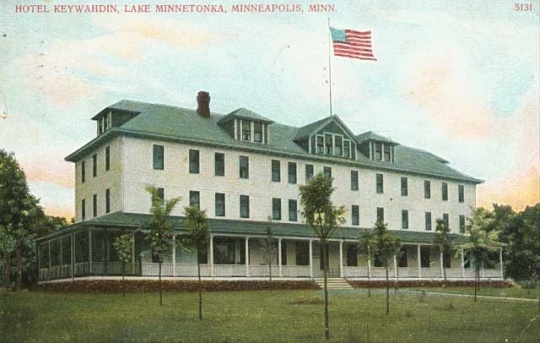
Hotel Keewaydin, Lake Minnetonka
Color postcard of the Hotel Keewaydin, c.1910.
Public domain
Holding Location
Articles
More Information

Hotel Lafayette, Minnetonka Beach
Black-and-white photograph of the Hotel Lafayette, c.1883.
Public domain
Holding Location
Articles
More Information
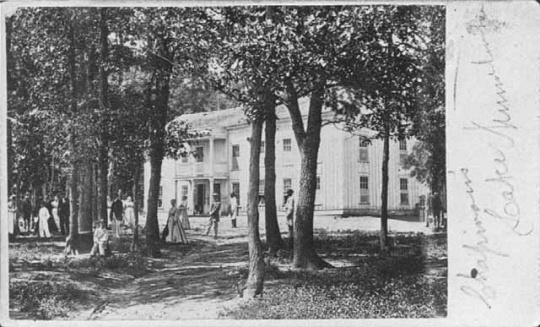
Chapman's Hotel, Lake Minnetonka, Mound
Carte-de-visite of Chapman's Hotel, c.1875.
Public domain
Holding Location
Articles
More Information
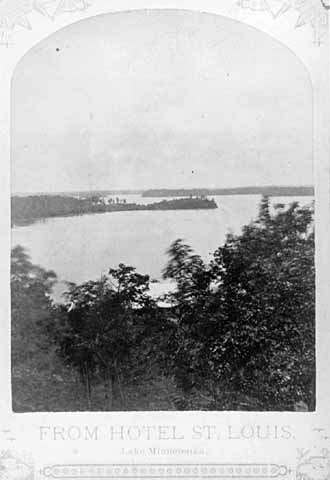
View of Lake Minnetonka from the Hotel Saint Louis
Public domain
Holding Location
Articles
More Information
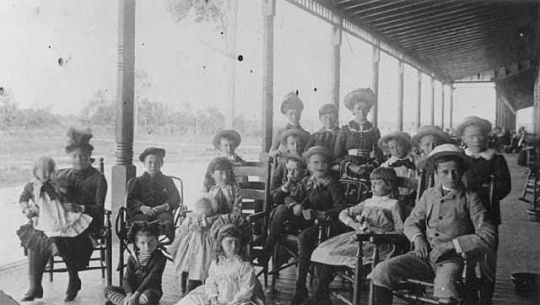
Children on porch of Lafayette Hotel, Minnetonka Beach
Black-and-white photograph of children on the Porch of the Lafayette Hotel, c.1890.
Public domain
Holding Location
Articles
More Information
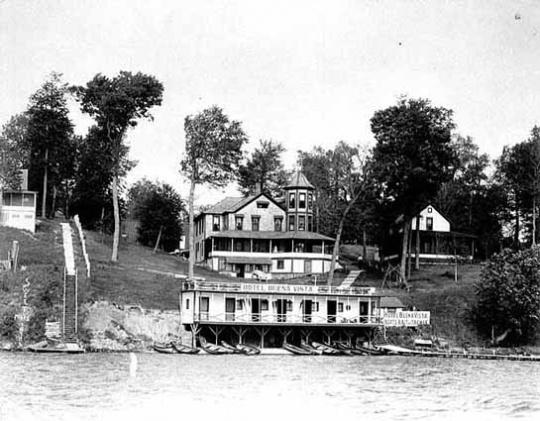
Hotel Buena Vista, Lake Minnetonka, Mound
Lake view of the Hotel Buena Vista in Mound, 1905.
Public domain
Holding Location
Articles
More Information
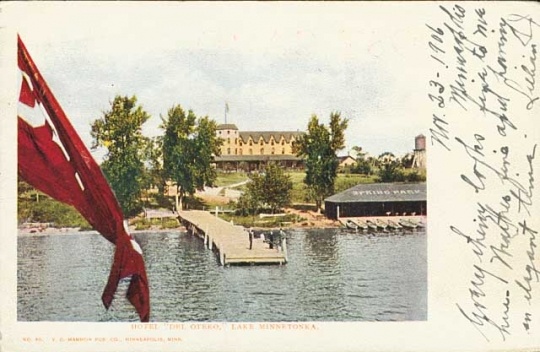
Hotel Del Otero, Lake Minnetonka
Color photograph of the Hotel Del Otero, c.1906
Public domain
Holding Location
Articles
More Information

Keewaydin Hotel, Lake Minnetonka, Deephaven
Photograph of dock at Keewaydin Hotel, Deephaven, c.1908.
Public domain
Holding Location
Articles
More Information
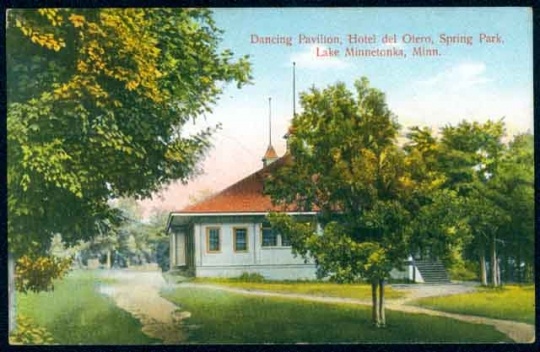
Dancing Pavilion, Hotel del Otero, Spring Park, Lake Minnetonka
Color postcard of the Dancing Pavilion at the Hotel Del Otero, c.1910.
Public domain
Holding Location
Articles
More Information
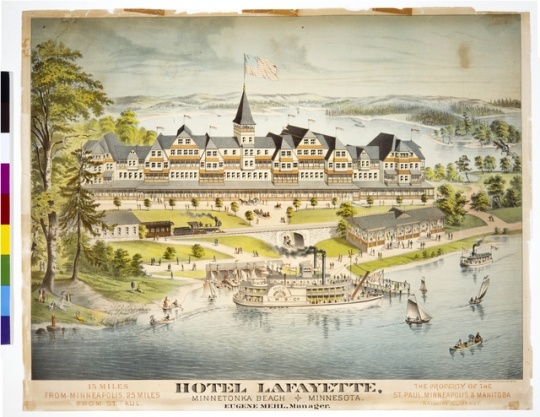
Hotel Lafayette, Minnetonka Beach
Lithograph of Hotel Lafayette, Minnetonka Beach, 1883. Lithographer unknown.
Public domain
Holding Location
More Information
Related Articles
Turning Point
The Hotel Lafayette opens its doors in 1882. With its impressive lake views and ornate parlors and dining rooms, the Lafayette draws nearly ten thousand guests in its first season, marking the high point of Lake Minnetonka's resort hotel industry.
Chronology
c.1853
1854
1867
1879
1879
1882
1885
1897
1907
1911
1945
Bibliography
Hammel, Bette Jones. Legendary Homes of Lake Minnetonka. St. Paul: Minnesota Historical Society Press, 2010.
Johnson, Frederick L. The Big Water: Lake Minnetonka and its Place in Minnesota History. Minnetonka, MN: Deep Haven Books, 2012.
Meyer, Ellen Wilson. Lake Minnetonka's Historic Hotels. Excelsior, MN: Excelsior–Lake Minnetonka Historical Society, 1997.
"Minnetonka." Minneapolis Journal, August 7, 1902.
Ogland, James W. Picturing Lake Minnetonka: A Postcard History. St. Paul: Minnesota Historical Society Press, 2001.
Wayzata Historical Society. About Wayzata.
http://www.wayzatahistoricalsociety.org/AboutWayzata.htm
Related Resources
Primary
"Beautiful Minnetonka: America's Great Northwestern Health Resort. Some of the Features that Entitle this Resort to Your Careful Consideration." National Health Journal, Special Illustrated Minnetonka Edition VIII, no. 12 (June 15, 1899).
Ellis, S.E. Picturesque Lake Minnetonka: the most popular summer resort in the great northwest. Minneapolis: Mitchell Printing Co., 1909.
"The Lake Beautiful." St. Paul Daily Globe, June 21, 1885.
http://chroniclingamerica.loc.gov/lccn/sn90059522/1885-06-21/ed-1/seq-13/
"Lake Minnetonka, the Summer Resort and the Permanent Home." Minneapolis Journal, May 13, 1905.
http://chroniclingamerica.loc.gov/lccn/sn83045366/1905-05-13/ed-1/seq-15/
Lake Park Hotel, Lake Minnetonka, Minn.: Where to spend your summer: Boating, Fishing, Yachting, Driving, Tennis, Etc., Etc. Chicago: Poole Bros., 1897.
Loring, Sarah. "Summer Loitering at Lake Minnetonka." Lakeside Monthly 10 (1873): 365–375.
The Season of 1904, Tonka Bay Hotel, Lake Minnetonka, Minnesota: opens June 23. Excelsior, MN: Tonka Bay Hotel, 1904.
"Trolley's Advent Means New Era for Minnetonka." Minneapolis Journal, May 13, 1905.
Secondary
Diers, John W. and Aaron Isaacs. Twin Cities by Trolley: The Streetcar Era in Minneapolis and St. Paul. Minneapolis: University of Minnesota Press, 2007.
Heilbron, Bertha L. "Minnesotans at Play." Minnesota History 36, no. 3 (September 1958): 89–94.
http://collections.mnhs.org/MNHistoryMagazine/articles/36/v36i03p089-094.pdf
Koutsky, Kathryn Strand and Linda Koutsky. Minnesota Vacation Days: An Illustrated History. St. Paul: Minnesota Historical Society Press, 2006.
Ogland, James W. Lake Minnetonka Historic Insights: discovery and legends. Wayzata, MN: Dnalgo Publications, 2010.
Soukup, Judy. A New Village on the Lake: Minnetonka Beach, 1894–1994. Minnetonka Beach, MN: Minnetonka Beach Civic Association, 1994.
Web
Excelsior-Lake Minnetonka Historical Society. Hotel Photograph Collection.
http://www.elmhs.org/exhibits/vex10/index.htm











